


|
|
 |
|
|
Navigation LakesnWoods.com
© 2004-2025 DCMA, Defamation, Copyright and Trademark Infingement Policy
Greetings from Northern Minnesota Mug
|
|
|
|
Many of the North Dakota homesteaders were Scandinavians who came from forested lands. Then they learned of new lands within Minnesota's lakes and forests, they sold their claims on the Dakota prairies and headed east.
In 1888, brothers George
Earl and Merian Ellsworth Carson left their father's trading post at Moose,
a village on the Mississippi River. They cut a wagon trail seventeen miles
due east to the lake where Shaynowishkung lived. Chief Bemidji and others.
There, they built Carson's Trading Post, becoming Bemidji's first white
businessmen. In 1894 Merian Carson applied for a permit for Post Office.
As Bemidji's first postmaster, it took him four years to correct the postal
service's misspelling from `Bermidji to 'Bemidji'.
Shaynowishkung's daughter, Bahgahmaushequay, married Merian Carson, thereby
cementing the relationship between the original inhabitants and the white
newcomers.
Most white inhabitants were either lumber company cruisers or homesteaders,
like Freeman and Betsy Doud, who staked their claim to 160 acres west of,
and including, what is now Diamond Point. They were Bemidji's first homesteaders
and were followed shortly thereafter by the Porter Nye family, who settled
on the east end of Lake Irving (in what later became the village of Nymore).
These, and other white pioneers, honored Shaynowishkung for his staunch friendship. Although he was not a tribal chief, Shaynowishkung was respectfully called 'Chief Bemidji' by those he provided food and shelter while they were building their homestead cabins.
Tams Bixby and His Company Town
Rosemary Given Amble
|
|
In 1895, Tams Bixby,
A.C. Clausen, Harris A. Richardson and Dr. Harry Hutchinson of St.
Paul and W.J. Hilligoss, Albert Kaiser, and Lewis Lohn, of Fosston,
bought ninety-three acres of land on Lake Bemidji with the original
idea of establishing a townsite. In January, 1896, the seven organized
the Bemidji Townsite and Improvement Company and in March, Bixby
and Clausen filed the plat of Village of Bemidji at the Ramsey County
Courthouse. The townsite was surveyed, platted and drawn by Charles A. Forbes of St. Paul. The gridwork of streets were named First through Eighth. Bixby and Clausen named the avenues: Lake Boulevard for the lake; Bemidji, for the village; Beltrami, for the county; Minnesota, for the state; and America, for the country. |
May 20, 1896, the Village of Bemidji was incorporated. Board Chairman Bixby was Governor David Clough's secretary. Clausen was a St. Paul attorney, Hutchinson, a physician, Kaiser a newspaperman and Lohn, a Fosston bank president.
Bemidji's three newspapers had ads to sell Townsite lots for $75 - $100 each. Pioneer publisher, Albert Kaiser reported that the Company had appointed four local Bemidji businessmen to be Village Trustees. The appointees were George Carson, Bemidji's first businessman, Guy Remore, son of Bemidji's first hotel owner and his new partner, George McTaggert. The fourth was Fred Malzahn, owner of the newly completed Hardware, Dry Good and Grocery Store. At their first meeting on August 24, 1896, Fred Malzahn was elected president and Pioneer publisher, Kaiser, was their recorder.
|
|
With Kaiser to be their major
advisor, the St. Paul stockholders used all of their powers of persuasion
to sell the village lots. Each time Bixby returned to Bemidji, he visited
Freeman and Betsy Doud and collected small quartz rocks from the sandy point
of land on the Doud's homestead. St. Paul newspapers printed articles about
precious gems being found in Minnesota's northernmost village. Doud's point
of land was called `Diamond Point'.
Businessmen came from St. Paul and others from the Dakotas to buy Townsite
lots. Most commercial lots were for hotels, restaurants, saloons, gambling
and gaming houses, and other establishments common to a growing logging
town.
At the first annual stockholders'
meeting, Bixby reported that Beltrami County would soon split from Becker
County and the county seat would be moved from Detroit (Lakes). The legislature
was yet debating which village would be selected: Bemidji, at the southeast
corner of the county; Buena Vista, about mid-point in the state's largest
county; or Popple or Moose, both to the southwest section. Each had strong
lobbyists at St. Paul vying for the appointment. At Bixby's suggestion,
the Townsite Company voted to donate a lot at 401 Beltrami Avenue from the
Original Townsite to be used for a courthouse. They also
donated a full block between Eighth and Ninth for a future elementary and
high school and they reserved another full block between Sixth and Seventh
for a new larger courthouse, a jail and a sheriffs house.
|
|
On August 8, 1897 Bemidji's lobby. Beltrami County Commissioner Frank Dudley and Attorney W.F. Street announced Bemidji was Beltrami's new county seat. The courthouse construction began and the town exploded in growth.
Great Northern Railroad's 1897 survey routed the railbed from Fosston to Duluth due north of Lake Plantagenet, but in St. Paul. Bixby was trying to get a new route. Great Northern's board chairman, James J. Hill, was his personal friend and before the year was over, Kaiser's newspaper announced that Hill had assured Bixby he would reroute thorough the south end of Bixby's village.
In 1898, with both a new county seat and the Great Northern Railroad, there was yet another major addition. Lumber baron John Pillsbury owned major stands of white pine north of Lake Bemidji and before he could harvest those forests, he needed rail connections to his mills in Brainerd and Minneapolis. By the end of 1898, the Brainerd and Minnesota Railways, a subsidiary of Northern Pacific, extended into the Village of Bemidji from the south.
In 1899 Lake Park Addition, between Tenth and Twelfth Street and Lake Boulevard to Bemidji Avenue, was added and lots sold for finer lakefront homes. A full block at 800 and the lakefront was set aside for the construction of the St. Anthony's Hospital.
The rail connections between Bemidji and both St. Paul and Grand Forks brought loggers, lumberjacks and speculators, as well as modern building supplies. Bixby chose a summer home site on the north side of the lake and referred to it as Oakwood Beach. Like other lakeshore residents, he used a steam-powered paddlewheeler for transportation.
|
|
When his home was completed,
Bixby invited Joseph M. Markham, a Minnesota legislator from St. Hilaire,
and convinced him that the Village of Bemidji needed a fine new hotel like
Markham had just built in Crookston. During the 1899-1900 winter, Markham
shipped materials from St. Paul and built a large, elegant hotel on Second
Street and Beltrami Avenue. When the Markham Hotel was opened, the Town-site
Company moved its offices from the Remore into the Markham Hotel.nt> Tams Bixby was a main speaker
at the Markham's grand opening. Newspapers reported that he stressed how
Bemidji was the favored stopping place for Minnesota's salesmen. He urged
the businessmen who were in attendance to organize a Bemidji Commercial
Club, saying they could hold their meetings at the Townsite Company's business
offices and they would donate the costs of all correspondence. With his captive audience,
Bixby spoke eloquently on his favorite subject. He was quoted saying 'Bemidji
will become Minnesota's favorite summer and health resort, and the summer
sojourner will find ready, at hand, an infinite variety of ways and means
with which to while away the long hours of a summer's day. The devotee of
rod and reel and the chase could scarcely choose a more inviting point than
that offered by Bemidji.' Following thunderous applause
and before leaving the podium, Bixby announced the Company was proposing
to construct a $6,000 village town hall at Minnesota Avenue and Fourth Street.
It would house village offices, a fire hall and a jail and on the third
floor, there would be an Opera House for traveling chautauguas, fine musicals
and literary group programs. Bixby inspired the businessmen to move forward. That September, shortly after
the village hall dedication, a 45-man fire brigade was organized and a Bemidji
Boys' Band started practicing in the Opera House. By January 1903 Shevlin and
his new partner Elbert Carpenter bought Weyerhaeuser's timber north of Bemidji.
A large sawmill was built at the south end of Lake Bemidji in July. It was
called Crookston Lumber Mill #1. Bixby recommended that Bemidji
businessmen move to charter as a city. On November 19, 1903, businessmen
E.A. Trask, William McCuaig, G.E. Carson, F.W. Rhoda, Porter Nye, George
McTaggert, A. Gilmore, Wes Wright, and Matt Thome were appointed by the
District Judge H.W. Bailey to draft such a charter. It was completed in 1904 and
when put to a vote of the community, it was rejected. Again, in July of
1905 it was rejected by the voters. Then, at the September 26th election,
the charter was finally approved by a vote of 321 favoring and 202 in opposition.
By 1901, Walker had sold his Red River sawmill located in Crookston. Thomas
Shevlin and Frank Hixon were the buyers of the mill and Walker's Timber
claims near Lake Bemidji. The Bemidji Commercial Club approached this new
Crookston Lumber Company, asking them to open a branch on Lake Bemidji.
On November 14, with A. A. Carter appointed Mayor, the Village of Bemidji
held their first meeting as a governmental entity.
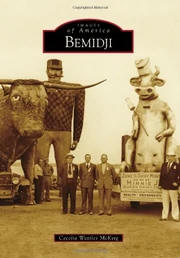
Bemidji (Images of America)
Bemidji links its early history
to that of Shay-now-ish-kung, or Chief Bemidji, who lived
with his family on the shores of the lovely lake bearing his
name. After the Carson brothers opened their trading post in
1888, logging flourished and lumber camps boomed. Bemidji
was incorporated in 1896, and the railroad reached the town
in 1898. Hotels, businesses, and saloons mushroomed near the
railroad tracks. Saloons and a brisk nightlife kept Bemidji
in the news until federal agent W.E. "Pussyfoot" Johnson and
his deputies closed the saloons and made it a more
respectable place to live. Early settlers took advantage of
the beautiful shoreline to develop summer hotels and parks.
Kodak reported that the spot where the statues of Paul
Bunyan and Babe the Blue Ox stand is the
second-most-photographed tourist attraction in the United
States.
Buy This Book Now!
Early Bemidji Businesses In 1895, John Steidl's sawmill
was on the Mississippi River's east bank, not far from the Indian village
and Carson's Trading Post. On the west side of the river were the Remore
Hotel and Carl Carlson's blacksmith shop. By the time Bemidji was incorporated
on May 20, 1896, there were three publishing companies. Albert Kaiser, a
Townsite shareholder, came February 22, and in March published Bemidji's
first newspaper, The Bemidji Pioneer. Its weekly articles centered around
the Townsite's activities. Within the month the Beltrami County News was
printed by C.W. Martin. Its news was primarily about the county development.
In late April Clarence Speelman came from Buena Vista and built his Beltrami
Eagle west of George Carson's New Carson House on the south side of Third
Street. Publisher Speelman felt the federal post office would never correct
spelling error and he advertised Bermidji's Sawmill'. Volume I, No. 17 of his paper,
printed July 31, 1896, advertised William Bartletson's Stage and Express
Service that carried mail between Bemidji and Park Rapids every other day.
An article described the ox-drawn wagon that stopped at Lake George for
a noon meal. When it arrived in Bemidji long after dark, Earl Geil, clerk
at Remore's Grand Central Hotel took tired passengers to Ted Smith's Gem
Restaurant for a meal and his welcome to the new village. Speelman reported
Smith's menus usually had freshly caught fish, wild rice and berries supplied
by a nearby `friendly' band of Indians.
Others advertised in Speelman's
July 31, 1896, Eagle were George Carson, New Carson House at Third and Beltrami
next to Smith and Bate's Gem Restaurant and Jewett and Son's Sectional Maps,
located in the Eagle publishing office across Third Street from Frank Dudley's
and George Graham's Meat market. Further west, Dennis and Miller's Meat
Market was between Fred Malzahn's general store and H.C. Geil's Livery and
Freighters. All these were on Third Street and C.F. Schroeder's general
store was aroud the corner on Minnesota Avenue. Also, an item on the Eagles's
front page read "The Indians brought a large quantity of blueberries this
morning."
Rosemary Given Amble

Bank of Bemidji built in 1897
located on 4th and Minnesota.
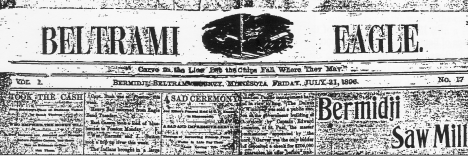
The Beltrami Eagle from July 31, 1896.
Notice the spelling "Bermidji".
Speelman's Eagle ceased operation in 1897 when Beltrami's county seat was established in Bemidji and Speelman was appointed Beltrami County Clerk of Court. He took office the day the Bank of Bemidji was opened on the corner of Third Street & Minnesota Avenue.
By 1898, the two railroads
had arrived in Bemidji, bringing more businesses to Third Street. From the
lake, J.J. Trask opened his Bemidji Steam Laundry at 106 Third Street and
next to the City Drug was William McCuaig's and then Luddington's General
Hardware Store. Beyond the Gem Restaurant, the Fred Brinkmans opened his
hotel and her restaurant. Across the street E.L. Naylor built his furniture
and mortuary.

City Drug Store opened in 1897
on Third Street
Architect Thomas Johnson designed Charles Nangle's general mercantile at 300 Minnesota. On the second floor Dr. Blakeslee oversaw his hospital rooms.
By 1900, the population of the Village of Bemidji had grown to 2,000. Seven additions doubled the size of the original ninety-three acre Townsite. George Carson's Addition was from Irvine to Park, Woodland to Eighth. The Townsite's First Addition was south of First along the Original, and Lake Park Addition was Tenth to Twelfth, Lake Boulevard to Bemidji. E.J. Swedback's Addition was west of Carson's Addition, which was Lake Irving to Railroad Street. The Townsite Company added the South Bemidji Addition, including Carpenter and Clausen Avenue, Rosby and Wheeler Streets, Finally, lumberman Charles Ruggles added Bailey's Addition from Carson's Addition to Twelfth Street west of Irvine. The lots now sold for $1,000 in the Original Townsite.
The 1900 Sanborn maps also showed locations of Blocker and Carlson's bottling works, the Duluth, Fitger's Gluek, and Minneapolis Brewing depots, two cigar factories and a dozen barber shops. Besides the Brinkman and Markham Hotels, the City, Dewey, French, Svea, Lake Shore, Merchants, Palace, Scandia House and Schultz House made a total of eleven hotels. There were four female boarding houses south of Second Street and enough saloons to meet the demands.
By 1903, the Townsite Company
had built a Village Hall, Fire Hall, Opera House. Water Works and donated
land for a County Court House, St Anthony's Hospital, Warfield Electric
Company, two schools and four churches.
Transportation The earliest non-indigenous
people in the Headwaters area were traders. The Carson Brothers canoed seventeen
miles down the Mississippi from the Village of Moose. The first settlers
came by horseback, following Indian Trails from railroad terminals in adjacent
counties to both the west and south. Loggers opened those trails by widening
them into wagon roads. The southern trail, from Park Rapids, was so rough
that one settler said once he got to Bemidji, "he didn't want to go back...
so he stayed.." It took two days to travel from Park Rapids by ox cart in
1894, and Park Rapids and Bemidji merchants sponsored the cutting of a road
between the two villages to bring settlers and supplies to Bemidji.
In 1896 when the village incorporated,
a stage ran between Park Rapids and Bemidji. It was an ox-drawn wagon that
left at 6:00 a.m. and arrived at 10:00 p.m. Two years later the Bemidji
Pioneer reported "20 to 25 loaded freight wagons came into Bemidji containing
freight for railroad contractors...storekeepers and...immigrants." There
was still no rail service. Watercraft was a primary means
of transportation. When freight arrived by ox-cart, if destined for places
around the lake or for lumbercamps or villages north of Bemidji, it was
loaded onto a steam-powered paddlewheeler. Local blacksmith, Carl Carlson,
built `The Ida,' and launched it in Lake Bemidji in the spring of 1898.
For 20 years when the 200 passenger boat was not serving to boom logs to
the mills, it was a favorite recreational craft for the villagers. Other
boats included: W. B. MacLaughlin's 'The Shadow,' that carried passengers
to Diamond Point, Birchmont, Lavinia and Oakwood Beach; 'Thor' built by
Andy Lee and the 'Eagle' built by L.C. Curtis. A boat owned by Herb Warfield
was moored at Diamond Point and Cameron Park in the 1940s. Don Holmes'
28 passenger 'Dixie Belle' was launched July 4, 1953 and his larger `Bemidji
Belle' traveled Lake Bemidji until 1973. In 1987 a new factory-made 'Bemidji
Belle' graced the lake for two summers.
Back in the 1890s, James J.
Hill was chairman of Great Northern Railway Company's board and had shown
an unerring judge of the resources and the latent wealth in Dakota's wheat
production. Just as his railway shipped wheat eastward in the early 1890s,
he was looking to ship northern Minnesota lumber to the west in the early
1900s. He contracted with a Pacific Ocean steamship company to ship lumber
to the Asiatic coast, Australia and the East Indian and many European ports,
saying "I shall not rest until I have taken from Chicago all of that northwestern
lumber which has previously gone to the head of the lakes." Hill's profound words were
followed by rapid fulfillment. Bemidji residents watched anxiously, knowing
the original railroad survey had the eastbound lines platted four miles
south of their village along the north side of Lake Plantagenet. In 1898,
word came to the business leaders from the Governor's office that the Eastern
Minnesota Railway, an extension of Great Northern Railway, would bring rails
from Fosston into Bemidji. A small frame freight depot was built. Great Northern's Eastern Railroad
extended to Cass Lake and from there to both Duluth and St. Paul. With that
extension Great Northern was shipping large volumes of lumber to their western
United States markets.
The next year the Brainerd
and Minnesota Railroad Company, a subsidiary of Northern Pacific, extended
its rails from Walker into Bemidji and transported John Pillsbury's logs
to his mill in Minneapolis. By 1900 the company was reorganized and renamed
the Minnesota and International Railroad Company. After building a depot
at Second Street and Bemidji Avenue, rails were extended to the new village
of Blackduck. In 1905 John Moberg's crew
completed the tracks that eventually carried the Minneapolis, Red Lake and
Manitoba Railway from the north shore of Lake Irving to Nebish and from
there to Redby on Lower Red Lake. It was a logging train but provided passenger
and freight service to the Red Lake Indians, farmers and homesteaders along
the line. It was referred to as the Molander Line, named for the district
manager and ticket agent. In 1910 the Minneapolis, St.
Paul and Sault St. Marie, known as the Soo Line, was extended from Duluth
paralleling the Eastern Railway tracks into Bemidji, Leonard, Gonvick and
Clearbrook. They shared tracks with the Minnesota and International and
built a $20,000 brick depot. The Union Station opened July 24, 1911. Bemidji now had five different
railway companies shipping logs, lumber, freight and passengers into and
out of Bemidji. James J. Hill was now past
board chairman of the Great Northern Railroad Company, but he was still
influential in the board's decision-making. He directly instigated the design
of a new Bemidji depot, one that was comparable to the Union Station. By
summer of 1912, a brick freight and passenger depot was completed at the
south end of Minnesota Avenue. It was the last of Hill's major northern
Minnesota depots to be constructed and, as such, is on the National Historic
Trust list. By 1905 automobiles started
coming to Bemidji. John Moberg drove his from Grand Forks. About the same
time, Chad Jewett took two days to drive from Minneapolis via Sauk Center.
Walter Brooks, local banker, ordered his automobile to be sent by freight
from the Michigan factory. There is a dispute as to whose automobile was
first in town, but before the end of 1909 several gasoline carriages were
being stuck on Bemidji sandy streets. State and County roads and highways
were yet so bad that travel was not easy and railways continued as major
passenger services keeping Bemidji residents in touch with the world beyond.
The Red Lake Railroad disappeared with the sawmills and the original right-of-way
became a gravel road.
As national rail service declined
in '50s and '60s, so did Bemidji's rail service. Great Northern and Northern
Pacific merged with the Chicago, Burlington Northern system. This union
brought the demise of northern Minnesota's north/south rail service. Bemidji's
last passenger train coincided with the establishment of Amtrak, the National
Passenger Railway system, which determined the end of the Duluth to Grand
Forks Burlington Northern line through Bemidji. Tracks from International
Falls to Brainerd via Bemidji were removed in the late 1980s when the land
was placed in Minnesota's land bank. The right-of-way is being converted
to a recreational trail for snowmobiles, bicycles and hikers. Today, the primary freight
traffic is unit coal trains from the western states to power companies on
the Iron Range and return. The Soo Line, now a subsidiary of the huge Canadian
Pacific Transportation Network, will shortly abandon Bemidji's rails and
share use of the Burlington Northern Line. This leaves Bemidji with two
railroads operating on single main line trackage. As it was in the early 1900s,
the primary rail commodity shipped from Bemidji is wood products. Some are
for pulp & paper industries, others are hardwoods for veneer & specialty
wood products. As the railroads disappeared,
the federal and state governments developed highway systems. U.S. Highway
#2, which originally bisected Bemidji, was one of the nation's oldest major
east/west federal transportation routes. U.S. Highway #71 was the major
north/south federal thoroughfare. Greyhound Bus Lines, an over-the-road
bus service that started in Hibbing, Minnesota, served Bemidji in the late
1920s. That service to Minneapolis and Grand Forks, plus Triangle Lines
to International Falls, still continues. Local bus service and charters
originally were privately owned and operated by the Aylesworth family. The
city owns the buses and recently, using Minnesota Transit funds, the City
Bus was started. Through a contract with Mark Daniels Enterprises, the city
provides local Dial-A-Ride bus service that allows patrons to call, be picked
up and taken to their destination from any place in town. In the 1980s the Minnesota
Department of Transportation completed a highway encircling three sides
of Bemidji to allow the ever-growing grain truck traffic to by-pass Bemidji.
This by-pass intersects Highway #2 two miles east of the city and at the
Bemidji-Beltrami Airport to the west. Bemidji's most recent mode
of transportation is by air. The first airplane in Bemidji was a bi-plane.
Local carpenter Harry Slough helped Katherine Stinson assemble the plane
that arrived by freight in 1915. When Katherine Stinson and her brother
left Bemidji, they went to California where they built the Stinson Aeronautical
School. There she taught flying and built airplanes like the one that had
been displayed at the Beltrami County Fairgrounds in 1916.
One of the first Bemidji passengers
to fly with Katherine Stinson was young Ralph Moberg, who later owned Moberg
Anchorage and Flight Service. He is credited with teaching most of Bemidji's
pilots how to fly. In 1920 Bemidji Civic and Commerce
bought land north and west of Bemidji and gave it to the city for an airport.
Using Work Relief Project monies in 1934, the city built a $41,000 90' X
90' hangar on their airport. On May 4, 1940, a local physician, Dr. W.M.
Haller brought a three-passenger 120 horsepower Rearwim Cloudster airplane
to Bemidji Municipal airport from Fargo. His comment was that "Bemidji's
field was rather rough. Too rough to handle any machine that flies as fast
as 50 miles per hour." But faster planes were soon to be seen in Bemidji. On January 26, 1946, nearing
the end of World War II, Dick Goodrich and John Kenfield purchased a Noorduyn-Norseman
plane plane to start a seven passenger airline. They incorporated Bemidji
Airlines on April 1, referring to it as the Paul Bunyan Playground Route.
Daily two hour flights, costing $10.00 per passenger brought businessmen
and tourists back and forth from Minneapolis and Bemidji, with one stop
at St. Cloud. Bemidji was one of the first Minnesota regional cities with
airline services. Bemidji Airlines also provided Forest Rising's chartered
airline service, for his Paul Bunyan Airline. Another local air service
was Moberg's Sea-plane Flights under the supervision of one of Bemidji's
aldermen, Ralph Moberg. On June 1 & 2, 1946, Bemidji
dedicated a million dollar airport financed by the federal government as
part of their defense project. The ceremony included views of 29 Navy planes,
16 Army planes and 140 civilian planes and the Army's P80 Shooting Star
that flew 550-600 miles per hour. Mayor Harry Pihl and former
mayor Earl Bucklin accepted the new airport from the state commissioner
of aeronautics. It had 5,700 feet of surfaced runways and a thousand feet
sod safety zones at each runway end. One of the officials said, "Why, it's
bigger than Wold Chamberland." Airport News, a national publication of the
Nation's Airports issued at Washington, D.C., wrote: "Bemidji is one of
the smallest cities in the country to possess an airport of its size . .
. 8,000 foot runways. Because Bemidji lies about 75 miles from the Canadian
border and is in a great vacation region, and because of the extremes of
winter temperatures, Army and Navy may use the field as a scene of tests
for cold weather air operations." For the past fifty years, besides
Bemidji Airlines, passenger service was provided by North Central Airlines,
locally referred to as the Blue Goose. In the mid-1980s the City of Bemidji
and Beltrami County formed a joint powers agreement for the management of
the Bemidji-Beltrami Airport, from which Mesaba Airlines fly their Northwest
Airlink and United Airlines who provide United Express services. These two
operations give Bemidji approximately ten daily passenger flights to and
from Bemidji and Minneapolis. Bemidji Aviation Services, the spin-off of
the Bemidji Airlines incorporated in 1946, is owned by Larry Diffley and
Mark Shough and presently provides charter and freight services.
Dick Rose
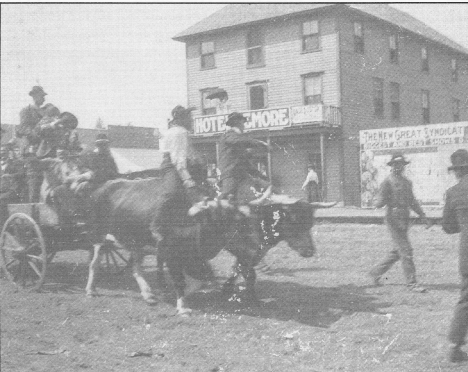
Remore Hotel built 1895. Ox-drawn cart
is stage from Park Rapids.
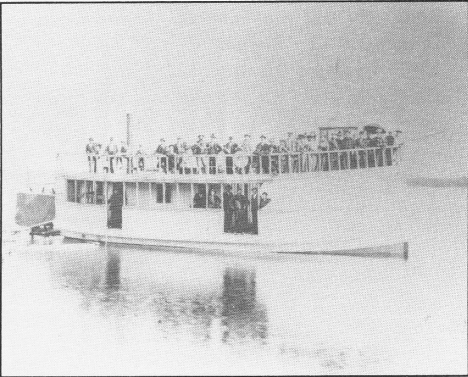
The Ida - 1898

Union Station built 1910 at First and Beltrami.
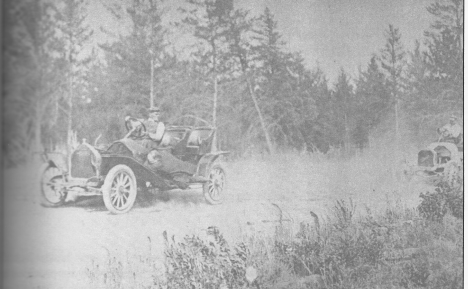
Automobile race between Moberg and Jewett in 1899.
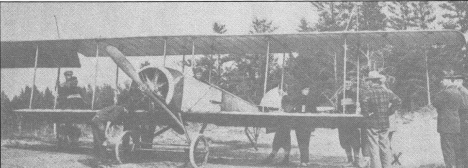
The first airplane in Bemidji 1915.
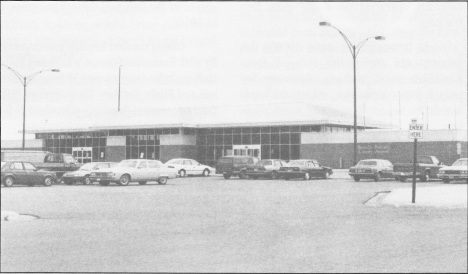
The Bemidji Airport built in 1992.
|
|
|
|
|||||
|
|
© 2004-2025 LakesnWoods LLC All Rights Reserved |
|
|||
|
|
|||||